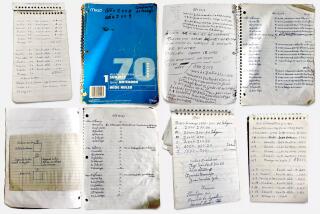Mercy Hospital, a Century of Service to Poor : Care: A hundred years after its beginning, one of San Diego’s best-known hospitals still lives up to the beliefs of its founders.
When two Sisters of Mercy came to San Diego a century ago, with just $50 between them, their mission was simple: They would set up a hospital and care for the sick, including people who couldn’t pay.
After renting rooms above a downtown clothing store, Mother Mary Michael and Sister Mary Alphonsus opened St. Joseph’s Dispensary in 1890.
A lot has changed since then. Tiny St. Joseph’s Dispensary has grown into Mercy Hospital, a few days from celebrating its centennial and now the third-largest hospital in San Diego, after the Navy and Veterans hospitals.
One thing has not changed, the philosophy on treating the poor.
“The Sisters of Mercy take a vow to care for the poor, the sick and the uneducated,” said Sister Mary Jo Anderson, vice president at the hospital.
Sister Mary Jo said that year the hospital last year provided more than $6 million in charity care, which doesn’t include all the free work doctors do, and those numbers keep adding up, for Mercy and the other hospitals in the area that provide charity care.
“It’s worth it if people’s lives are saved,” Sister Mary Jo said.
Patients at the hospital pay on sliding scale.
In the early days of the hospital, people often brought produce, signed over deeds to their land, or bartered for their services. Now the hospital sees people going to different extremes when faced with paying off a medical bill, even after the hospital and the doctors have swallowed much of the cost.
Kathy Wilson, the director of the hospital’s Mercy Clinic, remembers one young man who helped pay for his grandmother’s hip replacement surgery.
“The doctor donated the prosthesis, but they needed a little more money, so, without anyone asking, he sold his new car,” Wilson said. Mercy Clinic was opened in 1961 and has more than 31,000 patient visits each year.
The hospital has come a long way since its beginning on July 9, 1890, in the cramped quarters above the clothing store. In 1891, the sisters moved the hospital to a new three-story building at 8th and University avenues and, in 1924, the hospital moved to its present location. The 11-story building on the site today was built in 1966.
What began as a five-bed dispensary is now the 523-bed Mercy Hospital and Medical Center with a medical staff of more than 1,200.
Many of the doctors on the staff, in keeping with the sisters’ mission, have volunteered their services, and no one in medical distress is ever turned away.
“In emergency room trauma or in the clinic, we take care of them,” Wilson said.
A portion of the charity care that the hospital gives out is spread around to cover the medical costs of people who can’t pay because they’re uninsured, or under insured, migrant or undocumented workers from Mexico, homeless people and the more than 35 women each month who, without previous prenatal care, go to the hospital ready to deliver their babies, Sister Mary Jo said.
The $6 million in charity care last year does not include any Medi-Cal patients, said Debbie Seitz, a spokeswoman for the hospital.
Mercy Hospital has not always had a smooth time of it. In 1987 the hospital threatened to pull out of the state’s embattled Medi-Cal health insurance program because of low reimbursement rates. The hospital changed its mind after state health officials it a better daily reimbursement.
In the hospital’s earlier days, the high cost of giving charity care was balanced out by charging those patients who could afford them higher prices. But, because such rate differences are no longer allowed, other ways had to be found.
“Today, we just have to be a little more creative,” Sister Mary Jo said.
The hospital raises the money it needs to care for the poor through such groups as The Mercy Hospital Foundation, the Mercy Hospital Auxiliary and contributions from the United Way. Two weekends each year, Mercy works with COAD International Field Programs, a group that provides free surgical care to people from around the world. During the time that COAD (an old English word meaning to help ) is at Mercy, 12 operating rooms are staffed with supplies donated by pharmaceutical companies so that doctors who have volunteered their time can perform more than 75 operations, said John Martin, director of COAD in San Diego.
He said those services normally would cost more than half a million dollars.
On Sunday, from noon until 4 p.m. the hospital will celebrate its centennial with a plaque dedication ceremony, entertainment, food, a health fair and tours of the hospital. All events are free.
More to Read
Sign up for Essential California
The most important California stories and recommendations in your inbox every morning.
You may occasionally receive promotional content from the Los Angeles Times.










